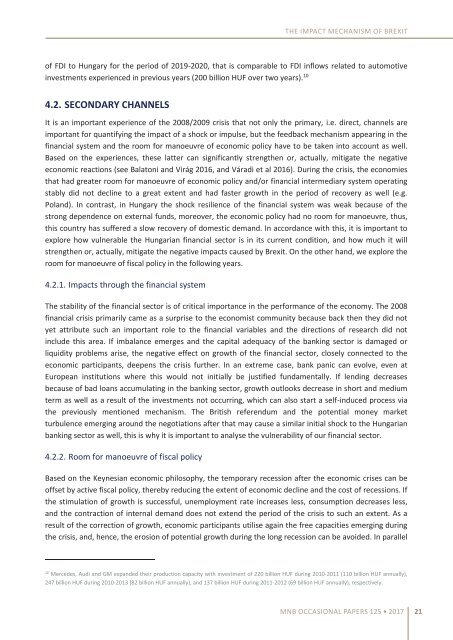mnb-op-125-final
Create successful ePaper yourself
Turn your PDF publications into a flip-book with our unique Google optimized e-Paper software.
THE IMPACT MECHANISM OF BREXIT<br />
of FDI to Hungary for the period of 2019-2020, that is comparable to FDI inflows related to automotive<br />
investments experienced in previous years (200 billion HUF over two years). 10<br />
4.2. SECONDARY CHANNELS<br />
It is an important experience of the 2008/2009 crisis that not only the primary, i.e. direct, channels are<br />
important for quantifying the impact of a shock or impulse, but the feedback mechanism appearing in the<br />
financial system and the room for manoeuvre of economic policy have to be taken into account as well.<br />
Based on the experiences, these latter can significantly strengthen or, actually, mitigate the negative<br />
economic reactions (see Balatoni and Virág 2016, and Váradi et al 2016). During the crisis, the economies<br />
that had greater room for manoeuvre of economic policy and/or financial intermediary system <strong>op</strong>erating<br />
stably did not decline to a great extent and had faster growth in the period of recovery as well (e.g.<br />
Poland). In contrast, in Hungary the shock resilience of the financial system was weak because of the<br />
strong dependence on external funds, moreover, the economic policy had no room for manoeuvre, thus,<br />
this country has suffered a slow recovery of domestic demand. In accordance with this, it is important to<br />
explore how vulnerable the Hungarian financial sector is in its current condition, and how much it will<br />
strengthen or, actually, mitigate the negative impacts caused by Brexit. On the other hand, we explore the<br />
room for manoeuvre of fiscal policy in the following years.<br />
4.2.1. Impacts through the financial system<br />
The stability of the financial sector is of critical importance in the performance of the economy. The 2008<br />
financial crisis primarily came as a surprise to the economist community because back then they did not<br />
yet attribute such an important role to the financial variables and the directions of research did not<br />
include this area. If imbalance emerges and the capital adequacy of the banking sector is damaged or<br />
liquidity problems arise, the negative effect on growth of the financial sector, closely connected to the<br />
economic participants, deepens the crisis further. In an extreme case, bank panic can evolve, even at<br />
Eur<strong>op</strong>ean institutions where this would not initially be justified fundamentally. If lending decreases<br />
because of bad loans accumulating in the banking sector, growth outlooks decrease in short and medium<br />
term as well as a result of the investments not occurring, which can also start a self-induced process via<br />
the previously mentioned mechanism. The British referendum and the potential money market<br />
turbulence emerging around the negotiations after that may cause a similar initial shock to the Hungarian<br />
banking sector as well, this is why it is important to analyse the vulnerability of our financial sector.<br />
4.2.2. Room for manoeuvre of fiscal policy<br />
Based on the Keynesian economic philos<strong>op</strong>hy, the temporary recession after the economic crises can be<br />
offset by active fiscal policy, thereby reducing the extent of economic decline and the cost of recessions. If<br />
the stimulation of growth is successful, unemployment rate increases less, consumption decreases less,<br />
and the contraction of internal demand does not extend the period of the crisis to such an extent. As a<br />
result of the correction of growth, economic participants utilise again the free capacities emerging during<br />
the crisis, and, hence, the erosion of potential growth during the long recession can be avoided. In parallel<br />
10<br />
Mercedes, Audi and GM expanded their production capacity with investment of 220 billion HUF during 2010-2011 (110 billion HUF annually),<br />
247 billion HUF during 2010-2013 (82 billion HUF annually), and 137 billion HUF during 2011-2012 (69 billion HUF annually), respectively.<br />
MNB OCCASIONAL PAPERS <strong>125</strong> • 2017 21


